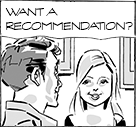Page 45 Review by Publisher Blurb
Who calls their own comic BOBBINS?
Well, John Allison, obviously.
Of course, it might not be self-deprecation: a man with such intimate knowledge of the Singer Sewing Machine might well be referencing the weaving of threads -the intertwining of lives, as they move in and out of each other’s orbits. It’s something he’s spectacularly good at.
And here’s a hidden art you don’t see too often: between each of these perfectly timed, interconnected, vertical, four-panel gag strips with their own sublime beats and conversational cadence, there lies an extra beat. Some follow swiftly on from each other, to be sure, but not every conversation has to be heard. Instead it’s not just the strips themselves which move the narrative so swiftly on, but the judicious gaps in between.
I like that the left-hand strip on each printed page is raised a little above the right. That too carries its own momentum -a musical ebb and flow rather than the comparatively regimented monotony of next, next, next. These are the details that matter.
From the creator of sundry other BAD MACHINERY bobbins like GIANT DAYS and EXPECTING TO FLY (Page 45’s biggest-selling comic last year) comes a self-contained, signed and limited edition comic both written and drawn by John Allison which focuses on the employees of a British local newspaper called City Limit.
I love that the paper’s called City Limit, singular. It only has one. And it’s not even a city, it’s the town called Tackleford.
The cast includes familiar faces from EXPECTING TO FLY including Shelley Endeavour Winters who’s starry-eyed with enthusiasm at the prospect of her first shared accommodation yet worried about the potential finality of leaving home. Once fully fledged, will she still have a room there to go back to? It’s a familiar inner conflict, but the joy lies in the unexpected, even extreme ways it’s expressed.
Then there is this: John Allison’s characters have an inner life in which their minds are ticking and whirring internally and independently of each other so that when one responds or interjects, the other is often still ruminating on their own train of thought, as if the other hadn’t even spoken.
"Shelley. I don’t think writing a sex column means you have to go out there and rut furiously. You have to be more of an anthropologist."
"A priapic David Attenborough? So I’d use a night vision camera."
"I reckon you’re looking for anecdotal evidence, not a prison sentence."
"Do you think work will pay for one?"
Shelley’s still thinking optimistically of the night-vision camera, not the prison sentence. Same thing happens here:
Similarly there’s a photo-shoot sequence to publicise this local paper’s sex column -which Shelley’s really not sure that she’s up to, but she did go and blurt out the idea in a brainstorming session -from which Amy physically ejects the inept, gangly-limbed Rich with much visual mangling and invites Shelly to devour the camera "As if you don’t bone it soon, a volcano will spontaneously erupt".
Immediately you see Shelley’s grateful adoration for the intervention, but not The Look. For that you’re made to wait for its delayed effect at the bottom of the subsequent strip, for once Shelley’s mastered this empowering advice, she cannot let go. The satori and success of it is still buzzing in her head.
"Shelley, the photo shoot is over. Stop doing The Face."
How often in any medium do you see this oh-so-astutely observed human trait of a lingering daydream or train of thought?
"Wow, That’s a good trick, Amy."
"I know. You look like a five alarm fire at a fuck factory."
And that’s what I mean about cadence.
It’s all so exquisitely well drawn. The range of expressive emotions each character undergoes within a mere four panels is riveting. Each character is animated -as in not just brought to life, but to vivid movement as when Amy presses her palms together and Shelley sashays away into the foreground at the bottom of the page and into the next instalment, one forearm in front of her slinking, sliding hips.
Let’s talk fashion sense, and the crisp triangles of white shirt jutting out from under Shelley’s jumper. They don’t hang, they jut.
Let’s talk background details like the Tetris poster hanging from Shelley’s home bedroom wall, a nod to Allison’s EXPECTING TO FLY earlier in Shelley’s life in which Tetris was used as a metaphor for coping with life. Or the punchline to one particular page of brainstorming which doesn’t come in the dialogue, but on Len’s flipchart assessment of the finance-free idea of inviting a catalysed citizenship to contribute to the paper instead of his already ill-paid minions:
"Unworkable Utopian Options."
There is so much lurking beneath the surface, so many skills which don’t trumpet themselves and shouldn’t. As Edward Albee (‘Who’s Afraid Of Virginia Woolf’) once wrote "I don’t like symbolism that hits you over the head. A symbol should not be a cymbal." You shouldn’t hear it clash. Similarly you shouldn’t read something as if it’s being written in front of you -almost hear the keyboard being punched -or see it being drawn. To enjoy a comic we shouldn’t necessarily perceive all the meticulous work that goes into making it so wickedly witty and enjoyable. I just thought it was about time I did that for John Allison, because this is the very best of British comedy in any medium, with far more depth than that epithet implies.
I’m probably going to witter on about the hair next time. There’s some great hair here.
Every one of our copies is signed!

